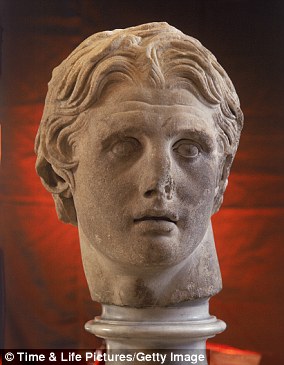Is this Alexander the Great’s escort? Tomb of a courtesan who may have seduced the Macedonian king is discovered after 2,300 years
The grave of a courtesan who seduced the elite ‘during the campaigns of Alexander the Great’ has been discovered after 2,300 years.
Found south of Jerusalem, Israel, it contained the cremated remains of a young woman, and a rare box mirror that looks “as if it was made yesterday.”
Experts say she was a hetaira – a high-class escort from ancient Greece who offered elite clients not only sex, but also companionship and intellectual stimulation.
And she may have plied her trade by accompanying the armies of Alexander the Great, or those who fought for his vast empire after the conqueror’s demise.
The discovery, detailed in a new study, is believed to be the first Hetairai tomb ever found.

The grave of a courtesan who seduced the elite ‘during the campaigns of Alexander the Great’ has been discovered after 2,300 years


Experts say she was a hetaira – a high-class escort from ancient Greece who offered elite clients not only sex, but also companionship and intellectual stimulation. And she may have plied her trade by accompanying the armies of Alexander the Great (depicted in this mosaic found in Pompeii), or by those who fought for his vast empire after the conqueror’s demise.


Experts say she was a hetaira – a high-class escort from ancient Greece who offered elite clients not only sex, but also companionship and intellectual stimulation
Co-author Guy Stiebel, an archaeologist at Tel Aviv University, said it also offered the earliest evidence of cremation found in Israel from the Hellenistic period.
The study concludes: ‘It is very likely that this is the grave of a woman of Greek descent who accompanied a high-ranking member of the Hellenistic army or government during the campaigns of Alexander the Great or, more likely, during the wars of the Diadochi (successors). ‘
Dr. Stiebel said the mysterious nature of the grave initially raised questions.
He said: ‘The most stimulating one was: what is the grave of a Greek woman doing on the highway leading to Jerusalem, far from any site or settlement of that period?
‘The tomb in particular intrigued us, also considering the fact that archaeological information about Jerusalem and its surroundings in the early Hellenistic period is very scarce.’
The rare box mirror proved crucial to unraveling the mystery.
Liat Oz, who led the dig for the Israel Antiquities Authority (IAA) and was also a co-author of the new study, emphasized how exclusive the item was.
She said: ‘This is only the second mirror of this type discovered in Israel so far.
‘And in total there are only 63 mirrors of this type known in the Hellenistic world.
‘The quality of the mirror is so high that it has been preserved in excellent condition and looks as if it was made yesterday.’


Found south of Jerusalem, Israel, it contained the cremated remains of a young woman, and a rare box mirror (pictured) that looks ‘as if it was made yesterday’


The researchers revealed that such mirrors were usually associated with Greek women, and often decorated with idealized females or goddesses such as Aphrodite – the goddess of love.
The researchers revealed that such mirrors were usually associated with Greek women, and often decorated with idealized females or goddesses such as Aphrodite – the goddess of love.
They also noted that a woman might receive one as a dowry prior to her marriage or – if it was a hetaira – as a gift from a client.
But the grave’s location along the road and its distance from a settlement indicated that the deceased accompanied an army on the move – something Greek women rarely did.
Therefore, they concluded that the grave belonged to a hetaira.
Although the authors emphasized that hetairai were not purely sexual figures, some became wives of their clients and inspired famous works of art that were even displayed in temples.
Experts think the remains date from the late 4th or early 3rd century BC, when the site was far from any settlement – although today it is not far from Kibbutz Ramat Rachel.
Dr. Stiebel said future tests could reveal exactly which army escorted the woman.
He said: ‘There are several possibilities, ranging from the time of Alexander to the Diadochi and the first Syrian wars.
‘In any case, there are several clues in both the archaeological and historical records.


The location of the grave along the road and its distance from a settlement indicated that the deceased accompanied an army on the move – something Greek women rarely did
‘It is still too early to identify the exact ruler.
‘We hope that archaeometallurgical testing in the near future will shed more light on the story of this fascinating burial and mirror.’
IAA director Eli Escusido said: ‘This is an example of the combination of archeology and research at its best.
‘The study of an apparently simple object led us to a new understanding and a story that opens for us a window into a forgotten and vanished ancient world.
“Nowadays, researchers are using more and more technologies to gain more information, and maybe we can get to know that lady and her culture better.”

